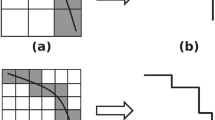Abstract
The tasks of traffic signs are notifying drivers about the current state of the road and giving them other important information for navigation. In this paper, a new approach for detection, tracking, and recognition such objects is presented. Road signs are detected using color thresholding, after that candidate blobs that have specific criteria are classified based on their geometrical shape and are tracked trough successive frames based on a new similarity measure. Candidate blobs that successfully pass the tracking module are processed for extracting their fractal features, and final recognition is done based on support vector machines with kernel function. Results validate effectiveness of newly employed fractal feature and show high accuracy with a low false hit rate of this method and its robustness to illumination changes and road sign occlusion or scale changes. Also results indicate that compared to the other pictogram feature representation techniques, this approach shows a more proper description of road signs.













Similar content being viewed by others
References
Gomez-Moreno H, Lopez-Ferreras F (2007) Road-sign detection and recognition based on support vector machines. IEEE Trans Intell Transportation Syst 8(2):264–278
Maldonado-Bascón S, Acevedo-Rodríguez J, Lafuente-Arroyo S, Fernández-Caballero A, López-Ferreras F (2010) An optimization on pictogram identification for the road-sign recognition task using SVMs. Comput Vis Image Underst 114(3):373–383
Bahlmann C, Zhu Y, Ramesh V, Pellkofer M, Koehler T (2005) A system for traffic sign detection, tracking, and recognition using color, shape, and motion information. In: ieee intelligent vehicles symposium (IV 2005), Las Vegas, NV, June 2005
de la Escalera A, Moreno L, Salichs MA, Armingol JM (1997) Road traffic sign detection and classification. IEEE Trans Ind Electron 44(6):848–859
de la Escalera A, Armingol JM, Mata M (2003) Traffic sign recognition and analysis for intelligent vehicles. Image Vis Comput 21:247–258
Miura J, Kanda T, Shirai Y (2000) An active vision system for real-time traffic sign recognition. In: Proceedings of IEEE intelligent transportation system, 1–3 Oct 2000, pp 52–57
Gomez-Moreno H, Maldonado-Bascon S, Gil-Jimenez P, Lafuente-Arroyo S (2010) Goal evaluation of segmentation algorithms for traffic sign recognition. IEEE Trans Intell Transport Syst 11(4):917–930
Fang C, Chen S, Fuh C (2003) Road sign detection and tracking. IEEE Trans Veh Technol 52(5):1329–1341
Aoyagi Y, Asakura T (1996) A study on traffic sign recognition in scene image using genetic algorithms and neural networks. In: Proceedings of 22nd IEEE international conference on industrial electronics, control instrumentation, Taipei, Taiwan, Aug 1996, 3, pp 1838–1843
Garcia-Garrido M, Sotelo M, Martin-Gorostiza E (2006) Fast traffic sign detection and recognition under changing lighting conditions. In: Sotelo M (ed) Proceedings of the IEEE ITSC pp 811–816
Liu Y, Ikenaga T, Goto S (2006) Geometrical, physical and text/symbol analysis based approach of traffic sign detection system. In: Procedings of IEEE intelligent vehicle symposium, Tokyo, Japan, June 2006, pp 238–243
Baro X, Escalera S, Vitria J, Pujol O, Radeva P (2009) Traffic sign recognition using evolutionary adaboost detection and forest-ECOC classification. IEEE Trans Intell Transport Syst 10(1):113. doi:12610.1109/TITS.2008.2011702
Soetedjo A (2007) Improving the performance of traffic sign detection using blob tracking. IEICE Electron Express 4(21):684–689
Vicen Bueno R, Gil-Pita R, Rosa-Zurera M, Utrilla-Manso M, Lopez-Ferreras F (2005) Multilayer perceptrons applied to traffic sign recognition tasks. In: Proceedings of the 8th international work-conference on artificial neural networks, IWANN, Vilanova i la Geltru, Barcelona, Spain, pp 865–872
Hibi T (1996) Vision based extraction and recognition of road sign region from natural color image, by using HSL and coordinates transformation. In: Proceedings of the 29th international symposium automotive technology and automation, Florence, Italy, 1996
Hsu SH, Huang CL (2001) Road sign detection and recognition using matching pursuit method. Image Vis Comput 19:119–129
Ruta A, Li Y, Liu X (2010) Robust class similarity measure for traffic sign recognition. IEEE Trans Intell Transport Syst 11(4):846–855
Prietoa MS, Allen AR (2009) Using self-organising maps in the detection and recognition of road signs. Image Vis Comput 27(6):673–683
Nguwi Y–Y, Kouzani AZ (2008) Detection and classification of road signs in natural environments. Neural Comput Appl 17(3):265–289
Gilani SH (2007) Road sign recognition based on invariant features using support vector machine. Master Thesis, Faculty of Electrical and Computer Engineering, Dalarna University, Sweden
Fleyeh H, Shi M, Wu H (2008) Support vector machines for traffic signs recognition. In: IEEE international joint conference on neural networks, 2008. IJCNN 2008 (IEEE World Congress on Computational Intelligence), pp 3820–3827
Lafuente-Arroyo S, Gil-Jiménez P, Maldonado-Bascón R, López- Ferreras F, Maldonado-Bascón S (2005) Traffic sign shape classification evaluation I: SVM using distance to borders. In: Proceedings of the IEEE intelligent vehicle symposium, Las Vegas, NV, June 2005, pp 557–562
Francçis A (2004) Real-time multi-resolution blob tracking. IRIS Technical Report, 2004
Soetedjo A, Yamada K (2005) Traffic sign classification using ring partitioned method. IEICE Trans Fundam Electron Commun Comput Sci E88(9):2419–2426
Zhang K, Sheng YH, Gong ZhJ (2007) A self-adaptive algorithm for traffic sign detection in motion image based on colour and shape features. In: Proceedings of SPIE, geoinformatics 2007: remotely sensed data and information, Nanjing, China, 6752, pp 6752G_1–6752G_13
Baldoni M, Baroglio C, Cavagnino D (2000) Use of IFS codes for learning 2D isolated-object classification systems. J Comput Vis Image Underst 77(3):371–387
Baldoni M, Baroglio C, Cavagnino D (1998) XFF: a simple method to eXtract fractal features for 2D object recognition. In: Amin A, Dori D, Pudil P, Freeman H (eds) Advances in pattern recognition, joint iapr international worshops SSPR’98 and SPR’98, Springer, Berlin/New York, pp 382–389
Piccioli G, Micheli ED, Parodi P, Campani M (1996) Robust method for road sign detection and recognition. Image Vis Comput 14:209–223
Artificial Intelligence Group in Islamic Azad University of Mashhad, available from World Wide Web. Accessed April 2010. http://en.mshdiau.ac.ir/index.php
Platt JC. Fast Training of support vector machines using sequential minimal optimization (Online). Available: http://research.microsoft.com/~jplatt
Author information
Authors and Affiliations
Corresponding author
Rights and permissions
About this article
Cite this article
Pazhoumand-dar, H., Yaghoobi, M. A new approach in road sign recognition based on fast fractal coding. Neural Comput & Applic 22, 615–625 (2013). https://doi.org/10.1007/s00521-011-0718-z
Received:
Accepted:
Published:
Issue Date:
DOI: https://doi.org/10.1007/s00521-011-0718-z




